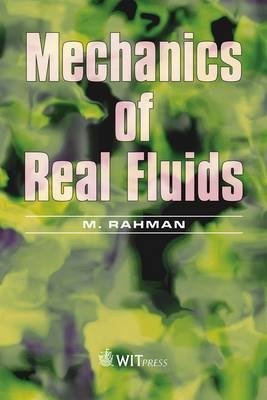
Mechanics of Real Fluids
WIT Press (Verlag)
9781845645021 (ISBN)
- Keine Verlagsinformationen verfügbar
- Artikel merken
Matiur RAHMAN is a leading applied mathematician and an expert in wave mechanics and wave loads on offshore structures. He retired as a professor in applied mathematics at Dalhousie University in Canada, after a long, distinguished career as an educator. Dr. Rahman is also the Chairman of the International Conference on Advances in Fluid Mechanics. He has written a number of best- selling titles for Wessex Institute of Technology Press, including Mathematical Methods with Applications (a Choice Outstanding Academic Title), Complex Variables and Transform Calculus, and Applied Differential Equations for Scientists and Engineers.
Contents Chapter 1 Introduction; Preliminary background; Real and ideal fluids; Specification of the motion; Outline of the book Chapter 2 The equations of fluid motion; Introduction; The equations of motion; The mechanical energy equation; The Boussinesq approximation; The Bernoulli equation; The Reynolds stresses; Derivations of equations of motion, Conservation of mass; Euler's equation of motion; Bernoulli's equation revisited; The existence of irrotational motion; Two-dimensional flow; Physical interpretation of velocity potential; Physical interpretation of stream function; Complex potential; Flow along a stream tube; Vortex kinematics; Vortexlines and vortextubes; Circulation; Vortex dynamics; The persistence of circulation; Line vortices and vortex sheets; Navier-Stokes equations of motion; Cartesian Coordinates; Cylindrical polar coordinates; Spherical polar coordinates; Exercises Chapter 3 Mechanics of viscous fluids; Introduction; Motion of a liquid in two-dimensions; Pressure distribution; The drag force on the cylinder; Motion in an axially symmetric 3D-body; Pressure distribution; The drag force on the sphere; Distinction between ideal and real fluids; Drag forces in a real fluid; Secondary Flows; Some exact solutions of Navier-Stokes equations; Steady flow between two-dimensional channel; -c - z; Steady flow through a circular section of radius c; Steady flow through the annular region b - c; Steady flow through an elliptic cylinder; Steady flow in a rectangular section; Steady Couette flow between rotating cylinders; Steady flow between parallel planes; Reynolds theory of lubrication; Steady flow due to a rotating circular disc; Some solutions of Navier-Stokes equations for unsteady flows; Flow due to motion of an infinite plate; Flow due to constant pressure gradient and motion of the plate; Flow due to oscillation of the plate; Very slow motion; Stokes's flow using tensor calculus; Stokes flow using vector calculus; Oseen flow; Exercises Chapter 4 Laminar boundary layers; Introduction; The concept of the boundary layer; Mathematical expression of the boundary-layer thickness d(x); Boundary layer Separation; Derivation of the boundary layer equations for flow along a flat plate; Boundary conditions for steady flow; Boundary layer equations for flow along a curved surface; Boundary-layer thicknesses, skin friction, and energy dissipation; Momentum and energy equations; Momentum integral; Energy integral; The von Mises transformation for steady flow; Analytical solutions of boundary layer equations; Flow along a flat plate at zero incidence in a uniform stream; Method of solution; Steady flow in the boundary layer along a cylinder near the forward stagnation point; Steady flow along a wedge: the Falkner-Skan solutions; Pohlhausen's method; Flow in laminar wakes and jets; Exercises147 Chapter 5 Similarity analysis in fluid flow; Introduction; Concept and definition of heat and mass diffusion; General statement of the problem; Similarity analysis of the basic equations; Use of the similarity variable; Use of the similarity variable; Natural convection flow along a vertical plate; Mathematical formulation; Method of numerical solution; Numerical results; Exercises Chapter 6 Turbulence; Introduction; The mechanism of transition to turbulence; The essential characteristics of turbulence; Reynolds equations for turbulent motion; Turbulent flow between parallel planes; Mixing-length theories of turbulence; Turbulent boundary layers; Correlation theory of homogeneous turbulence; Theoretical development of correlation theory; Isotropic turbulence; Spectral theory of homogeneous turbulence; Probability distribution of u(x); Calculation of the pressure covariance in isotropic turbulence; Exercises
| Erscheint lt. Verlag | 30.10.2010 |
|---|---|
| Zusatzinfo | Illustrations |
| Verlagsort | Southampton |
| Sprache | englisch |
| Maße | 155 x 230 mm |
| Themenwelt | Mathematik / Informatik ► Mathematik |
| Naturwissenschaften ► Physik / Astronomie ► Strömungsmechanik | |
| Technik ► Maschinenbau | |
| ISBN-13 | 9781845645021 / 9781845645021 |
| Zustand | Neuware |
| Informationen gemäß Produktsicherheitsverordnung (GPSR) | |
| Haben Sie eine Frage zum Produkt? |
aus dem Bereich


